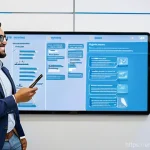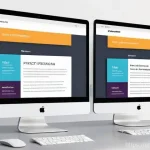The world of learning has completely transformed, hasn’t it? It feels like just yesterday we were stuck in rigid classrooms, but now, the sheer volume of incredible knowledge at our fingertips is both exhilarating and, let’s be honest, a little overwhelming.
That’s where the magic of self-directed learning comes in. I’ve personally found immense freedom in crafting my own educational journey, whether it’s mastering a new tech skill or diving deep into a personal passion.
Yet, even with all these amazing resources, navigating the vast digital ocean can be tricky. This is precisely why the roles of dedicated self-directed learning coaches and innovative learning platforms have become more crucial than ever.
They’re not just about delivering content; they’re about guiding you, helping you stay accountable, and unlocking your true potential in a way that traditional schooling simply can’t.
From what I’ve seen, the most successful platforms aren’t just content repositories, but vibrant ecosystems that truly understand how we learn best today, integrating personalized pathways and real-world application.
It’s about empowering you to take the reins of your own future, ensuring you’re not just consuming information, but truly growing. Let’s find out exactly how.
Embracing the Freedom: Why Self-Directed Learning is My Go-To

There’s just something incredibly empowering about taking the reins of your own education, isn’t there? For so long, we were conditioned to believe that learning happened within the four walls of a classroom, dictated by a strict curriculum and a set pace. But honestly, that never quite clicked with me. The moment I truly embraced self-directed learning, it felt like a huge weight lifted off my shoulders. It wasn’t about rigid schedules or memorizing facts for a test; it was about genuine curiosity and following my passion down whatever rabbit holes they led me. I remember feeling so frustrated with conventional methods when I wanted to dive deep into digital marketing. Traditional courses felt so slow and often outdated. That’s when I realized I could design my own syllabus, picking and choosing resources that were truly cutting-edge. This approach allowed me to learn at my own speed, revisit complex topics as many times as I needed, and skip over what I already knew. It transformed learning from a chore into an exciting adventure, making every new skill feel like a personal triumph rather than just another hurdle to clear. The sheer joy of discovering something new, entirely on my own terms, is an unparalleled feeling that keeps me coming back for more.
The Allure of Autonomy
What truly draws me to self-directed learning is the incredible sense of autonomy it offers. It’s about more than just picking your subjects; it’s about choosing your pace, your methods, and even your ideal learning environment. Imagine being able to dive into a coding bootcamp at 6 AM before the kids wake up, or spending an afternoon exploring ancient history documentaries when inspiration strikes. This flexibility is a game-changer for anyone with a busy life, allowing us to weave learning into the fabric of our daily routines rather than trying to force our lives around a rigid educational structure. I’ve personally found that when I have control over my learning journey, my engagement skyrockets. There’s a profound sense of ownership that comes with it, making the successes feel more earned and the challenges more surmountable. It’s not just about consuming information; it’s about actively sculpting your intellectual landscape.
My Personal Journey of Discovery
My own dive into self-directed learning wasn’t a sudden leap; it was a gradual, almost accidental, discovery. It started with a burning desire to understand web development better for my blog. Traditional college courses felt too broad and slow, so I turned to online tutorials and forums. What began as a necessity quickly became a preference. I loved the immediate feedback, the ability to experiment, and the countless resources available at my fingertips. I distinctly remember the thrill of debugging my first complex piece of code, a moment that felt far more significant than any grade I ever received in school. This journey led me to explore graphic design, then video editing, and now even a bit of linguistics, all driven by my own evolving interests. Each new skill built upon the last, creating a unique and incredibly personalized knowledge base that a conventional education simply couldn’t have provided. It’s a testament to the power of following your curiosity and trusting your own capacity to learn.
Finding Your North Star: Why a Self-Directed Learning Coach Can Be a Game-Changer
While the freedom of self-directed learning is amazing, let’s be real – sometimes it feels a bit like being adrift in a vast ocean without a compass. That’s where a fantastic self-directed learning coach swoops in to save the day. I’ve been there, staring at a mountain of online courses, books, and tutorials, feeling completely overwhelmed by choice. You know that feeling, right? “Where do I even begin? Am I learning the right things? Am I just wasting my time?” A coach isn’t just someone who tells you what to do; they’re more like a seasoned explorer who helps you chart your own course. They don’t provide all the answers, but they ask the right questions that help you uncover your own path. My own experience with a coach completely reshaped how I approached learning new, complex skills. They helped me articulate my goals, identify potential pitfalls, and, crucially, kept me accountable when my motivation inevitably waned. It wasn’t about being spoon-fed information, but about having a dedicated thinking partner who believed in my ability to figure things out, offering just the right nudge when I needed it most. It’s truly a collaborative journey that amplifies your inherent drive.
More Than Just a Mentor: A Guide and Accountability Partner
Think of a self-directed learning coach not just as a mentor, but as your personal strategic advisor and accountability partner rolled into one. They bring an outside perspective that can be invaluable when you’re deeply immersed in a subject. I remember vividly struggling with a particular aspect of data analytics; I was just going in circles. My coach didn’t give me the solution but instead asked, “What’s the core problem you’re trying to solve here? And what are three entirely different ways you could approach it?” That simple shift in perspective broke me out of my rut. Beyond guidance, the accountability factor is huge. Knowing I had a check-in call pushed me to complete tasks I might otherwise have procrastinated on. It’s that gentle but firm push that can make all the difference between an idea simmering in your mind and actually bringing it to fruition. They help you stay focused, celebrate your wins, and gently redirect you when you start to veer off course. It’s like having a personal trainer for your brain, ensuring you’re working out efficiently and effectively.
When I Realized I Needed a Coach (My “Aha!” Moment)
My “aha!” moment for needing a coach hit me hard when I was trying to pivot my career path towards more creative content creation. I had a ton of passion and a vague idea of what I wanted to achieve, but absolutely no structured plan. I was bouncing between YouTube tutorials on video editing, online courses on copywriting, and podcasts about brand strategy. It was exhilarating but also incredibly chaotic. I was making progress, but it felt incredibly inefficient, like trying to fill a bucket with a leaky sieve. I felt a constant nagging doubt: was I even learning the right things? Was there a more effective sequence? That’s when a friend suggested a learning coach, and initially, I was skeptical – wasn’t self-directed learning about doing it all yourself? But after just one introductory session, I realized what I was missing. The coach helped me break down my huge, amorphous goals into actionable, bite-sized steps, and suddenly, the path ahead seemed clear. It wasn’t about someone telling me *what* to learn, but *how* to learn it more effectively for *my* specific aspirations. It was truly transformative.
Navigating the Digital Ocean: Unlocking the Best Learning Platforms
The digital landscape is absolutely bursting with incredible learning platforms, which is both a blessing and, let’s be honest, a bit of a curse. With so many options, how do you even begin to pick the right one for you? I’ve spent countless hours sifting through different platforms, trying everything from massive open online courses (MOOCs) to niche communities, and I’ve learned a few things about what truly makes a platform shine. It’s not just about the sheer volume of content; it’s about how that content is delivered, the community it fosters, and whether it genuinely helps you apply what you’re learning. I’ve seen platforms that are essentially glorified digital textbooks, and then I’ve encountered others that are vibrant ecosystems designed to foster deep engagement and real-world skill development. My personal favorites are those that blend high-quality, up-to-date information with interactive exercises and opportunities to connect with fellow learners. A great platform can feel like a virtual university, offering structured paths, but with all the flexibility of self-directed learning. It should be intuitive, engaging, and make you excited to log in and learn something new.
Beyond Content: What Makes a Platform Truly Stand Out
When I evaluate learning platforms, I look far beyond just the course catalog. Sure, having a wide array of topics is great, but what truly makes a platform stand out from the crowd? For me, it boils down to features that enhance active learning and retention. Does it offer interactive quizzes and projects that allow you to apply what you’re learning immediately? Are there opportunities for peer feedback or instructor interaction? I’ve found that platforms with strong community features – forums, discussion boards, or even live Q&A sessions – make a massive difference. The ability to ask questions, share insights, and even collaborate on projects transforms a solitary learning experience into a dynamic, social one. I particularly appreciate platforms that integrate real-world case studies or allow you to build a portfolio of work as you progress. This practical application is what truly cements knowledge and gives you tangible skills you can use. Without these elements, even the best content can feel isolating and less impactful.
My Top Picks and Why They Work For Me
Over the years, I’ve tried a multitude of learning platforms, and a few have really stood out for their effectiveness and user experience. Coursera and edX, for example, are fantastic for structured, university-level courses, often with recognized certifications which can be a huge boost for career development. I particularly love their specialization tracks that guide you through a series of related courses. Then there’s Udemy, which is a treasure trove for practical, skill-based learning; it’s where I’ve picked up countless tips and tricks for everything from photography to advanced Excel functions. What I appreciate most about Udemy is the sheer variety and the ability to find a course on almost anything you can imagine, often taught by industry professionals. For more interactive and project-based learning, platforms like Codecademy for coding or Skillshare for creative skills are exceptional. They emphasize doing, which is absolutely crucial for skill acquisition. Each platform has its unique strengths, and often, the best approach is to blend resources from a few different ones to create your perfect personalized learning ecosystem. It’s about finding what resonates with your learning style and specific goals.
Crafting Your Blueprint: Strategies for Maximizing Your Learning Journey
Embarking on a self-directed learning journey is thrilling, but to truly make the most of it, you need a solid game plan. It’s not enough to just haphazardly consume information; you need a blueprint, a strategy that helps you move from intention to genuine mastery. I’ve learned this the hard way through countless hours spent feeling like I was spinning my wheels. The biggest shift in my learning journey came when I started to approach it with the same rigor and thoughtfulness I’d apply to a professional project. This isn’t about stifling creativity or making it feel like work; it’s about making your efforts incredibly efficient and impactful. Think about it: if you’re going to dedicate your precious time and energy to learning something new, you want to ensure that every minute counts, right? This means setting clear goals, understanding how you learn best, and actively engaging with the material in ways that go beyond passive consumption. It’s about building a robust system that supports your curiosity and transforms it into tangible knowledge and skills.
Setting Intentions and Smart Goals
The very first step to any successful learning journey, in my opinion, is setting crystal clear intentions and SMART goals. Without them, you’re just vaguely hoping to learn something, which often leads to fizzling out. I used to just say, “I want to learn Spanish,” but that’s far too broad. Now, I’d define it as, “I will be able to hold a 15-minute conversation in Spanish about my daily life by the end of six months, practicing 30 minutes daily using Duolingo and a conversation partner.” See the difference? That specific, measurable, achievable, relevant, and time-bound goal provides a roadmap. It helps you select the right resources and track your progress. I’ve found that writing these goals down and revisiting them regularly acts as a powerful motivator. When you know exactly what you’re aiming for, every learning session becomes purposeful, and you’re much less likely to get sidetracked by shiny new distractions. It empowers you to make intentional choices about how you spend your learning time.
The Art of Active Learning and Retention

Simply reading or watching a video isn’t truly learning; it’s just consuming. The real magic happens with active learning, and it’s something I’ve diligently cultivated over time. Passive consumption often leaves you with a fleeting understanding, but active engagement etches the information into your long-term memory. I swear by techniques like “teaching” what I’ve learned to an imaginary audience or a willing friend – explaining concepts out loud really highlights where my understanding is shaky. Another powerful method is spaced repetition, using flashcards (digital ones like Anki are brilliant!) to revisit information just as you’re about to forget it. And of course, hands-on projects. If I’m learning a new software skill, I immediately try to build something small with it. If it’s a new language, I try to use it in a conversation. Don’t just absorb; interact, question, apply, and create. This proactive approach not only boosts retention but also makes the entire learning process far more enjoyable and effective. It’s about getting your hands dirty and truly wrestling with the information until it becomes second nature.
The Secret Sauce: Blending Technology and Human Connection for Growth
In our hyper-connected world, it’s easy to fall into the trap of thinking that technology alone can solve all our learning needs. While digital tools and platforms are undoubtedly powerful, I’ve found that the real “secret sauce” for accelerating growth in self-directed learning lies in blending cutting-edge technology with genuine human connection. It’s a synergy that amplifies both aspects, creating a learning experience that’s far richer and more impactful than either could be on its own. Imagine having access to the world’s best online courses, but also having a mentor who understands your specific challenges, or a community of peers cheering you on. This combination not only combats the isolation that can sometimes creep into independent study but also provides invaluable perspectives and motivation. I’ve personally experienced how much faster I grasp complex ideas when I can discuss them with others, or when a seasoned expert points out a nuance I completely missed. Technology provides the content and structure, but human interaction breathes life into it, making it relevant and deeply personal. It’s about finding that sweet spot where digital convenience meets authentic human engagement.
The Synergy of Online Tools and Personal Interaction
The beauty of modern learning truly lies in how online tools can seamlessly integrate with personal interaction. I’ve leveraged this dynamic countless times. For instance, I might use an AI-powered language learning app to build my vocabulary and grammar basics, but then I’ll use that foundation to engage in live online conversation classes with a native speaker. The app gives me the repetition and instant feedback I need for foundational skills, while the human interaction forces me to apply those skills in a fluid, real-world context, addressing my specific errors and improving my fluency. Similarly, I use online coding platforms to practice algorithms, but then I’ll join a local hackathon or an online study group to collaborate on projects and learn from more experienced developers. The technology provides the accessible, structured practice, but the personal interaction provides the deeper understanding, nuanced feedback, and the irreplaceable feeling of shared progress. It’s truly a powerful combination that elevates the entire learning experience beyond what either component could offer alone.
Building a Learning Community That Fuels Your Drive
One of the most profound lessons I’ve learned in my self-directed journey is the immense power of a supportive learning community. When you’re learning independently, it’s incredibly easy to lose motivation, especially when you hit a challenging patch. That’s where a community comes in. It could be an online forum dedicated to your niche, a local meetup group, or even a few like-minded friends you regularly connect with. I’ve found that being able to share my struggles and celebrate my small wins with others who “get it” is an unparalleled motivator. They offer different perspectives, share valuable resources, and sometimes, just knowing you’re not alone in your learning journey is enough to keep you going. My best breakthroughs have often come from discussions with peers, where a simple question or a shared insight completely reshaped my understanding. These communities aren’t just places to ask for help; they’re places where you contribute, teach others, and deepen your own understanding in the process. It’s a symbiotic relationship that fuels everyone’s drive.
Measuring What Matters: Real-World Impact and Your Learning ROI
When we dedicate our precious time, energy, and sometimes even money to self-directed learning, we’re doing it for a reason, right? It’s not just about accumulating facts; it’s about making a tangible difference in our lives, careers, or personal pursuits. That’s why I firmly believe it’s crucial to think about the real-world impact of your learning and, dare I say, your “Return on Investment” (ROI). It’s not always about financial returns, though that can certainly be a part of it. Sometimes, the ROI is a newfound sense of confidence, the ability to pursue a dream hobby, or the satisfaction of solving a complex problem. I’ve personally experienced the immense gratification of seeing a skill I painstakingly learned translate directly into a successful project or a deeper understanding of the world around me. This isn’t about making learning feel transactional; it’s about ensuring that your efforts are purposeful and yield meaningful results that genuinely enrich your life. It’s about ensuring you’re not just passively absorbing information, but actively transforming yourself and your capabilities.
From Knowledge to Application: Seeing Tangible Results
The true litmus test of effective learning, in my experience, is moving beyond theoretical knowledge to practical application. It’s one thing to read a book on a new programming language; it’s another entirely to actually build a functional app with it. I’ve learned that until you’ve applied what you’ve learned in a real-world scenario, your understanding is often superficial. This is why I always try to incorporate projects or practical exercises into my learning plan. When I was learning about digital marketing analytics, I didn’t just study the metrics; I immediately applied them to my blog’s data, tracking changes and making informed decisions. Seeing those numbers shift, understanding the ‘why’ behind them, and then making adjustments that yielded positive results – that’s where the knowledge truly solidified. It’s that moment when theory meets practice, and you witness the tangible outcome of your efforts, that your learning feels truly validated and impactful. It’s a powerful cycle: learn, apply, observe, refine, and then learn even more effectively.
The Untapped Value of Continuous Growth
Beyond specific skills or immediate career benefits, there’s an even deeper, often overlooked, value in continuous self-directed learning: the cultivation of a growth mindset. This isn’t something you can quantify on a spreadsheet, but it’s arguably the most important ROI of all. The more you engage in self-directed learning, the more you realize your own capacity for growth and adaptation. You become more resilient in the face of challenges, more curious about the unknown, and more confident in your ability to acquire new skills whenever they’re needed. I’ve seen this play out in my own life time and time again. Learning a new skill isn’t just about that particular skill; it’s about strengthening your “learning muscle.” It builds a profound sense of self-efficacy and opens up entirely new avenues for personal and professional development. This ongoing cultivation of knowledge and adaptability isn’t just a fleeting benefit; it’s a foundational pillar for navigating an ever-changing world and continually unlocking new opportunities. It’s the ultimate investment in yourself.
| Aspect of Self-Directed Learning | Key Benefits | Practical Strategies for Success |
|---|---|---|
| Personalized Learning Paths | Tailored content, optimized pace, increased engagement. | Define clear learning objectives, choose diverse resources, adapt methods to your style. |
| Accountability & Support | Overcoming procrastination, staying motivated, gaining perspective. | Work with a learning coach, join a study group, set regular check-ins with peers. |
| Access to Diverse Resources | Unlimited information, variety of formats, up-to-date content. | Explore MOOCs, niche platforms, podcasts, books, and online communities. |
| Skill Application & Retention | Deep understanding, practical competence, measurable results. | Engage in projects, teach others, utilize spaced repetition, seek real-world application. |
| Community & Networking | Shared insights, collaborative opportunities, emotional support. | Participate in forums, attend virtual meetups, connect with mentors and fellow learners. |
Wrapping Things Up
And there you have it, fellow learners! Our journey through the exciting world of self-directed learning, from the sheer joy of forging your own path to finding incredible support and leveraging the best platforms out there. I truly hope this peek into my own experiences has sparked some ideas and given you the confidence to dive even deeper into what makes you tick. Remember, learning isn’t a race or a rigid curriculum; it’s a wonderfully personal adventure, constantly evolving with us. It’s about cultivating that innate curiosity and transforming it into tangible growth, one discovery at a time. The blend of technology and genuine human connection is truly where the magic happens, creating an ecosystem where we can all thrive and continuously unlock new levels of potential. Keep exploring, keep questioning, and most importantly, keep enjoying every single step of your unique learning journey. The world is truly your classroom!
Useful Information to Know
1. Embrace Metacognition: Thinking about how you learn, your strengths, and your weaknesses is a game-changer. Reflecting on your learning process allows you to adapt your strategies for better retention and efficiency. Regularly ask yourself what’s working and what isn’t.
2. Leverage AI for Personalized Paths: The latest trends in 2025 highlight AI’s role in creating truly personalized learning experiences. Use AI-powered tools and assistants to tailor content, get real-time feedback, and make your learning journey more efficient and engaging.
3. Prioritize Practical Application and Projects: Don’t just consume information passively. Actively engage with what you’re learning through hands-on projects, simulations, and real-world applications. This practical experience is crucial for solidifying knowledge and developing tangible skills.
4. Build a Supportive Community: While self-directed, learning doesn’t have to be solitary. Seek out online forums, study groups, or even local meetups related to your interests. Peer collaboration and feedback can provide invaluable perspectives and boost motivation.
5. Set SMART Goals and Monitor Progress: Clearly define what you want to achieve with specific, measurable, achievable, relevant, and time-bound goals. Regularly self-assess your progress against these goals to stay motivated and make necessary adjustments to your learning plan.
Key Takeaways
At the heart of it all, self-directed learning is about empowering yourself. It’s about recognizing that you hold the keys to your intellectual growth and professional development. The freedom to pursue subjects you’re passionate about, at your own pace, is incredibly liberating and deeply rewarding. Remember, the most effective learning journey skillfully blends a personal blueprint with the right digital resources and, crucially, a vibrant human connection. Don’t be afraid to experiment with new platforms, seek out a coach or mentor when you feel stuck, and always, always keep that curiosity burning brightly. By taking ownership of your learning, setting clear intentions, and actively applying what you discover, you’re not just acquiring skills; you’re building resilience, adaptability, and a lifelong love for exploration that will serve you incredibly well in our fast-changing world.
Frequently Asked Questions (FAQ) 📖
Q: Why should I even consider self-directed learning when there are so many traditional options out there?
A: This is a fantastic question, and one I’ve asked myself countless times! From my own experience, the biggest draw of self-directed learning is the sheer freedom and personalization it offers.
Think about it: traditional classrooms, while having their place, often move at a pace that doesn’t quite fit everyone. You might feel rushed through a topic you’re passionate about, or drag through one that doesn’t quite click.
With self-directed learning, you are in the driver’s seat. I’ve found that being able to dive deep into subjects that genuinely ignite my curiosity, at my own pace and in a way that truly resonates with my learning style, makes the whole process incredibly effective and, frankly, a lot more fun.
It’s not just about absorbing information; it’s about actively building skills that are directly relevant to your goals, whether that’s boosting your career, mastering a new hobby, or simply satisfying an intellectual craving.
You truly become the architect of your own growth, and that feeling of empowerment is, in my opinion, priceless.
Q: What’s the real difference a self-directed learning coach makes, and how do I find one that actually helps?
A: Oh, a self-directed learning coach can be an absolute game-changer! I used to think I could just “figure it all out” on my own, but let me tell you, navigating the vast digital ocean of information can be overwhelming.
It’s like having all the ingredients for a gourmet meal but no recipe or culinary guide. A great coach isn’t just someone who tells you what to learn; they’re more like a personal trainer for your brain.
They help you clarify your goals, identify effective resources, create a structured (yet flexible!) learning plan, and most importantly, keep you accountable when motivation wanes.
I’ve personally seen how having that external perspective can cut through confusion and keep me on track. When it comes to finding one, look for someone who genuinely listens to your aspirations and has a proven track record (check testimonials!).
A good coach will emphasize your journey, not just push a generic curriculum. Think about their style – do they seem supportive, challenging, or a good mix?
A quick chat or discovery call can really help you get a feel for their approach and if it aligns with how you learn best.
Q: With countless learning platforms available, how can I tell which ones are genuinely effective and will help me grow, not just consume information?
A: This is where it gets really interesting, isn’t it? It feels like a new platform pops up every other week! My personal litmus test for a truly effective learning platform goes beyond just a huge content library.
The best ones, in my experience, are those that foster a real sense of community and offer more than just passive viewing. I look for platforms that integrate practical application – think hands-on projects, interactive exercises, or opportunities to apply what you’re learning in real-world scenarios.
It’s not enough to just watch a video; you need to do something with that knowledge. Also, look for personalization features. Does it adapt to your progress?
Does it offer clear learning paths tailored to specific outcomes? The platforms that truly excel understand that learning isn’t a one-size-fits-all journey.
They often incorporate elements like progress tracking, peer feedback, and even live sessions or mentorship opportunities. It’s about finding an ecosystem that supports not just information delivery, but genuine skill development and allows you to truly engage with the material and connect with others on a similar path.
Don’t be afraid to try a few free trials to see what feels right for you!






